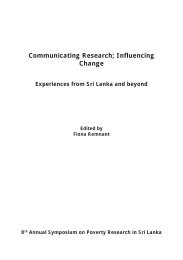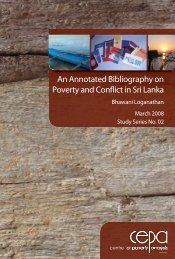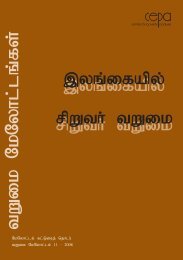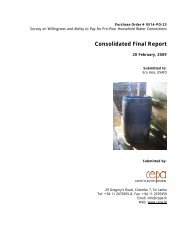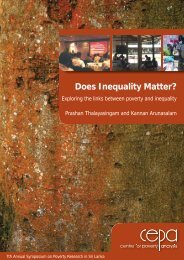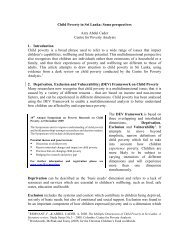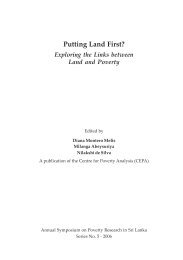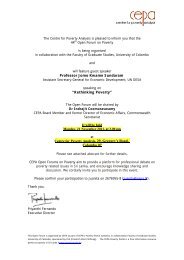Involuntary Displacement and Resettlement â Policy and ... - CEPA
Involuntary Displacement and Resettlement â Policy and ... - CEPA
Involuntary Displacement and Resettlement â Policy and ... - CEPA
- No tags were found...
You also want an ePaper? Increase the reach of your titles
YUMPU automatically turns print PDFs into web optimized ePapers that Google loves.
this view continues to dominate much research <strong>and</strong> action on internaldisplacement. They argue a need for a separate category of ‘internallydisplaced people’ because their experiences are very special <strong>and</strong> different,with special needs for assistance <strong>and</strong> protection. The other approach I referto as the ‘ICRC-approach’. Based on humanitarian principles <strong>and</strong> the realitiesof the field, the ICRC is critical of working with internal displacement as aseparate humanitarian category, <strong>and</strong> on the ground, ICRC does not separatebetween IDPs <strong>and</strong> other civilians affected by conflict – at least in principle:In situations of armed conflict <strong>and</strong> internal disturbances the ICRC will in factalways try to give priority to those with the most urgent needs. Because of theirprecarious situation, displaced persons are frequently, although notexclusively, among the main beneficiaries of its work. Moreover, the hostpopulations, which are sometimes minority groups or resident populations thathave been unable to move away, often have to face a situation that is just asdifficult, if not worse. Instead of developing programmes tailored to the needsof the displaced persons, it will then be necessary to adopt an overall approach<strong>and</strong> define the appropriate operational modes according to the context (ContatHickel 2001:699).Contat Hickel warns against the discriminatory nature of the IDP approachbecause of the specific mechanisms set up to respond to the need of onesingle category. ICRC’s approach is rather, when working in situations ofarmed conflicts, to provide protection <strong>and</strong> assistance to the entire civilianpopulation (Krill 2001).The ICRC approach is supported by a collaborative 3evaluation on donorsupport to IDPs (Borton et al. 2005). The evaluation shows that there is astrong objection to the identification of IDPs as a separate category,separating them from other actual <strong>and</strong> potentially vulnerable groupsbecause of practical difficulties in the field. A more fundamental source ofobjection reported in the evaluation was the belief that the separateidentification of IDPs is at odds with the humanitarian principle thatassistance should be determined by needs <strong>and</strong> needs alone.This is an important starting point for this paper: one school of thoughtadvocating the need for IDPs to be a separate category, the other taking theview that one needs to consider the needs of all vulnerable people in an area<strong>and</strong> that to single out a category based on one criteria – their forcedmovement – is problematic.3DANIDA, SIDA, Netherl<strong>and</strong>s MFA, ECHO, USAID, DFID <strong>and</strong> Development Cooperation Irel<strong>and</strong>,UNHCR, OCHA <strong>and</strong> WFP128



